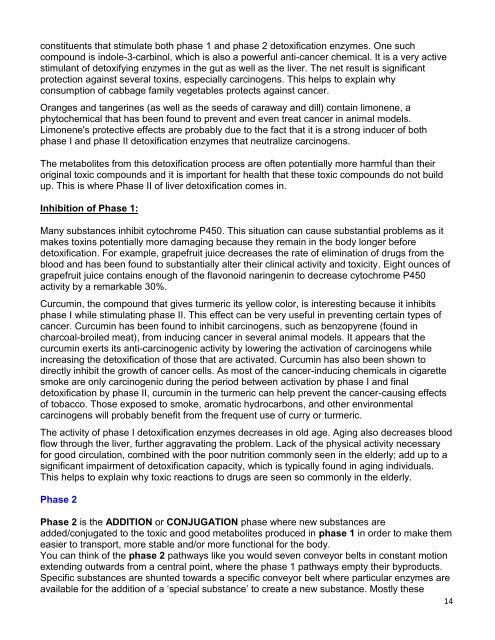Liver phases 1 and 2 detoxification pathways
Liver phases 1 and 2 detoxification pathways
Liver phases 1 and 2 detoxification pathways
Create successful ePaper yourself
Turn your PDF publications into a flip-book with our unique Google optimized e-Paper software.
constituents that stimulate both phase 1 <strong>and</strong> phase 2 <strong>detoxification</strong> enzymes. One such<br />
compound is indole-3-carbinol, which is also a powerful anti-cancer chemical. It is a very active<br />
stimulant of detoxifying enzymes in the gut as well as the liver. The net result is significant<br />
protection against several toxins, especially carcinogens. This helps to explain why<br />
consumption of cabbage family vegetables protects against cancer.<br />
Oranges <strong>and</strong> tangerines (as well as the seeds of caraway <strong>and</strong> dill) contain limonene, a<br />
phytochemical that has been found to prevent <strong>and</strong> even treat cancer in animal models.<br />
Limonene's protective effects are probably due to the fact that it is a strong inducer of both<br />
phase I <strong>and</strong> phase II <strong>detoxification</strong> enzymes that neutralize carcinogens.<br />
The metabolites from this <strong>detoxification</strong> process are often potentially more harmful than their<br />
original toxic compounds <strong>and</strong> it is important for health that these toxic compounds do not build<br />
up. This is where Phase II of liver <strong>detoxification</strong> comes in.<br />
Inhibition of Phase 1:<br />
Many substances inhibit cytochrome P450. This situation can cause substantial problems as it<br />
makes toxins potentially more damaging because they remain in the body longer before<br />
<strong>detoxification</strong>. For example, grapefruit juice decreases the rate of elimination of drugs from the<br />
blood <strong>and</strong> has been found to substantially alter their clinical activity <strong>and</strong> toxicity. Eight ounces of<br />
grapefruit juice contains enough of the flavonoid naringenin to decrease cytochrome P450<br />
activity by a remarkable 30%.<br />
Curcumin, the compound that gives turmeric its yellow color, is interesting because it inhibits<br />
phase I while stimulating phase II. This effect can be very useful in preventing certain types of<br />
cancer. Curcumin has been found to inhibit carcinogens, such as benzopyrene (found in<br />
charcoal-broiled meat), from inducing cancer in several animal models. It appears that the<br />
curcumin exerts its anti-carcinogenic activity by lowering the activation of carcinogens while<br />
increasing the <strong>detoxification</strong> of those that are activated. Curcumin has also been shown to<br />
directly inhibit the growth of cancer cells. As most of the cancer-inducing chemicals in cigarette<br />
smoke are only carcinogenic during the period between activation by phase I <strong>and</strong> final<br />
<strong>detoxification</strong> by phase II, curcumin in the turmeric can help prevent the cancer-causing effects<br />
of tobacco. Those exposed to smoke, aromatic hydrocarbons, <strong>and</strong> other environmental<br />
carcinogens will probably benefit from the frequent use of curry or turmeric.<br />
The activity of phase I <strong>detoxification</strong> enzymes decreases in old age. Aging also decreases blood<br />
flow through the liver, further aggravating the problem. Lack of the physical activity necessary<br />
for good circulation, combined with the poor nutrition commonly seen in the elderly; add up to a<br />
significant impairment of <strong>detoxification</strong> capacity, which is typically found in aging individuals.<br />
This helps to explain why toxic reactions to drugs are seen so commonly in the elderly.<br />
Phase 2<br />
Phase 2 is the ADDITION or CONJUGATION phase where new substances are<br />
added/conjugated to the toxic <strong>and</strong> good metabolites produced in phase 1 in order to make them<br />
easier to transport, more stable <strong>and</strong>/or more functional for the body.<br />
You can think of the phase 2 <strong>pathways</strong> like you would seven conveyor belts in constant motion<br />
extending outwards from a central point, where the phase 1 <strong>pathways</strong> empty their byproducts.<br />
Specific substances are shunted towards a specific conveyor belt where particular enzymes are<br />
available for the addition of a ‘special substance’ to create a new substance. Mostly these<br />
14


